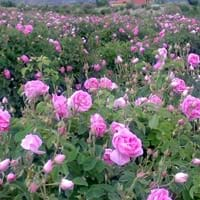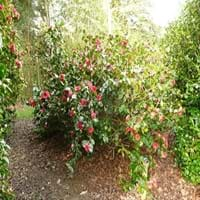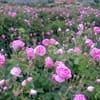Life Span
Perennial
Perennial
Type
Flowering Plants, Ornamental Plants, Perennial
Broadleaf Evergreen
Origin
Hybrid origin
China, Japan, Korea
Types
Summer Damasks, Autumn Damasks
Not Available
Habitat
gardens
Dappled Shade, Shady Edge, Woodland Garden
USDA Hardiness Zone
Not Available
7-9
AHS Heat Zone
Not Available
10-7
Sunset Zone
Not Available
4, 5, 6, 7, 8, 9, 12, 14, 15, 16, 17, 18, 19, 20, 21, 22, 23, 24
Habit
Clump-Forming
Oval/Rounded
Flower Color
Pink
Light Pink
Flower Color Modifier
Bicolor
Not Available
Fruit Color
Non Fruiting Plant
Black
Leaf Color in Spring
Green, Gray Green
Dark Green
Leaf Color in Summer
Dark Green, Green
Dark Green
Leaf Color in Fall
Green, Gray Green
Dark Green
Leaf Color in Winter
Dark Green, Green
Dark Green
Plant Season
Spring, Summer, Fall
Spring, Summer, Fall, Winter
Sunlight
Full Sun, Partial Sun
Partial Sun, Partial shade
Growth Rate
Medium
Medium
Type of Soil
Loam, Sand
Loam
The pH of Soil
Acidic, Neutral
Acidic, Neutral
Soil Drainage
Well drained
Average
Bloom Time
Spring, Late Spring, Early Summer, Summer, Late Summer, Early Fall, Fall
Early Spring, Late Winter
Repeat Bloomer
Not Available
No
Tolerances
Drought
Not Available
Where to Plant?
Container, Ground, Pot
Ground, Pot
How to Plant?
Cuttings
Cuttings, Seedlings
Plant Maintenance
Medium
Medium
Watering Requirements
Average Water Needs
Average Water Needs, Do Not over Water
In Summer
Lots of watering
Drought Tolerant, Average Water
In Spring
Moderate
Moderate
In Winter
Average Water
Average Water
Soil pH
Acidic, Neutral
Acidic, Neutral
Soil Type
Loam, Sand
Loam
Soil Drainage Capacity
Well drained
Average
Sun Exposure
Full Sun, Partial Sun
Partial Sun, Partial shade
Pruning
Remove damaged leaves, Remove dead branches, Remove dead leaves
Remove damaged leaves, Remove dead branches, Remove dead leaves
Fertilizers
All-Purpose Liquid Fertilizer
10-10-10, 8-8-8
Pests and Diseases
Beetles, Black Spot, Caterpillars, Downy mildew, Mosaic viruses, Powdery mildew, Rust, Scale insects, Thripes
Black Mold, Flower Blight, Free of serious pests and diseases, Leaf Gall, Leaf spot
Plant Tolerance
Drought
Not Available
Flower Petal Number
Double
Double
Edible Fruit
Not Available
No
Foliage Texture
Medium
Medium
Foliage Sheen
Glossy
Glossy
Invasive
Not Available
No
Self-Sowing
Not Available
No
Attracts
Birds, Butterflies
Butterflies
Allergy
Rash
no allergic reactions
Aesthetic Uses
Showy Purposes
Bonsai
Beauty Benefits
Not Available
Not Available
Environmental Uses
Air purification
Air purification
Medicinal Uses
Not Available
Astringent, Cancer, Haemostatic, Salve, Tonic
Part of Plant Used
Flowers
Flowers, Leaves, Seeds
Other Uses
Oil is used in perfume, soaps, creams, etc.
As a tea substitute, Used as a hair-dressing oil, Used for making green dye
Used As Indoor Plant
Yes
Yes
Used As Outdoor Plant
Yes
Yes
Garden Design
Container, Cutflower, Feature Plant, Foundation, Mixed Border, Topiary / Bonsai / Espalier
Feature Plant, Foundation, Mixed Border, Topiary, Bonsai, Espalier
Botanical Name
Rosa × damascena
CAMELLIA japonica 'Debutante'
Common Name
Damask rose, rose of castile
Camellia, Debutante Camellia, Japanese Camellia
In Hindi
जामदानी गुलाब
Japanese Camellia
In German
Damaszener-Rosen
Japanische Kamelie
In French
Le rosier de Damas
Camellia japonais
In Spanish
Rosa de Damasco, Rosa de Castilla
Camelia japonesa
In Greek
δαμασκηνό τριαντάφυλλο
Ιαπωνικά Camellia
In Portuguese
rosa damascena
Camellia japonês
In Polish
Róża damasceńska
Japoński Camellia
In Latin
surrexit Damascum
Camellia Italica
Phylum
Magnoliophyta
Magnoliophyta
Class
Magnoliopsida
Magnoliopsida
Clade
Not Available
Angiosperms, Asterids, Eudicots
Tribe
Not Available
Theaeae
Subfamily
Not Available
Theoideae
Number of Species
Not Available
Not Available
Season and Care of Damask Rose and Japanese Camellia
Season and care of Damask Rose and Japanese Camellia is important to know. While considering everything about Damask Rose and Japanese Camellia Care, growing season is an essential factor. Damask Rose season is Spring, Summer and Fall and Japanese Camellia season is Spring, Summer and Fall. The type of soil for Damask Rose is Loam, Sand and for Japanese Camellia is Loam while the PH of soil for Damask Rose is Acidic, Neutral and for Japanese Camellia is Acidic, Neutral.
Damask Rose and Japanese Camellia Physical Information
Damask Rose and Japanese Camellia physical information is very important for comparison. Damask Rose height is 200.00 cm and width 200.00 cm whereas Japanese Camellia height is 210.00 cm and width 165.00 cm. The color specification of Damask Rose and Japanese Camellia are as follows:
Damask Rose flower color: Pink
Damask Rose leaf color: Green and Gray Green
Japanese Camellia flower color: Light Pink
- Japanese Camellia leaf color: Dark Green
Care of Damask Rose and Japanese Camellia
Care of Damask Rose and Japanese Camellia include pruning, fertilizers, watering etc. Damask Rose pruning is done Remove damaged leaves, Remove dead branches and Remove dead leaves and Japanese Camellia pruning is done Remove damaged leaves, Remove dead branches and Remove dead leaves. In summer Damask Rose needs Lots of watering and in winter, it needs Average Water. Whereas, in summer Japanese Camellia needs Drought Tolerant, Average Water and in winter, it needs Average Water.





